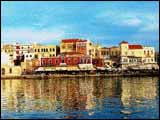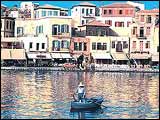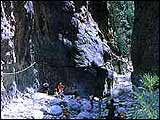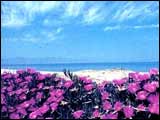|
 Chania is situated on the western part of the island. The landscape varies in Chania prefecture; there are exotic sandy beaches with crystal clear seas, high green mountains, gorges, like the famous gorge of Samaria as well as traditional mountain and coastal villages. During your tour, visit the impressive monasteries of the area, Chania town the capital of the prefecture of the same name, which is the most charming place and the Archaeological museum of the town.
Chania is situated on the western part of the island. The landscape varies in Chania prefecture; there are exotic sandy beaches with crystal clear seas, high green mountains, gorges, like the famous gorge of Samaria as well as traditional mountain and coastal villages. During your tour, visit the impressive monasteries of the area, Chania town the capital of the prefecture of the same name, which is the most charming place and the Archaeological museum of the town.
How to get there
- By air: from the Eleutherios Venizelos airport in Athens, or from the Macedonia airport in Thessaloniki.
- By ferry: from Piraeus to Souda in 10 hours.
Chania Town 
 Chania consists of the old town and the new town. While the new town is just a modern city with no special interest in terms of beauty and architecture, the old town concentrates all the sights of Chania. The Old walled town is an area with outstanding Venetian buildings from the 15th century. The town is centred around the pretty Venetian harbour, it includes areas such as the Venetian neighbourhood of Topanas at the western quarter with the finest Venetian mansions and Spiantzia north-east of the city with the church of Agios Nikolaos, which was turned into a mosque. Other sights are the Firkas fort, which was built in 1629 and used as a prison for Cretan insurgents, the large walls of the Venetian fortress built in 1540, Kasteli on the eastern side of the port and Sindrivani square (in our days Eleftherios Venizelos Square), which was a meeting-place for intellectuals in the early 20th century. In the old town of Chania except the historical monuments, there are many excellent restaurants, bars and small shops.
Chania consists of the old town and the new town. While the new town is just a modern city with no special interest in terms of beauty and architecture, the old town concentrates all the sights of Chania. The Old walled town is an area with outstanding Venetian buildings from the 15th century. The town is centred around the pretty Venetian harbour, it includes areas such as the Venetian neighbourhood of Topanas at the western quarter with the finest Venetian mansions and Spiantzia north-east of the city with the church of Agios Nikolaos, which was turned into a mosque. Other sights are the Firkas fort, which was built in 1629 and used as a prison for Cretan insurgents, the large walls of the Venetian fortress built in 1540, Kasteli on the eastern side of the port and Sindrivani square (in our days Eleftherios Venizelos Square), which was a meeting-place for intellectuals in the early 20th century. In the old town of Chania except the historical monuments, there are many excellent restaurants, bars and small shops.
Archaeological Museum 
 It is housed in the Venetian Church of San Francesco from the 14th century. There are exhibits from the Geometric and the Archaic period as well as finds from the zenith of Hellenistic times. The museum collection also includes findings from the post-Neolithic and post Minoan times including vases, figurines, jewellery and seal all funeral gifts found in necropolises.
It is housed in the Venetian Church of San Francesco from the 14th century. There are exhibits from the Geometric and the Archaic period as well as finds from the zenith of Hellenistic times. The museum collection also includes findings from the post-Neolithic and post Minoan times including vases, figurines, jewellery and seal all funeral gifts found in necropolises.
Gorge of Samaria 
 Walking through the gorge of Samaria is a unique experience, but only if you’re in good physical shape. It has been declared a national park, and can only by visited between May and October when the river is low. It is the longest gorge in Europe at a total length of 18 km and ranges in width from 3 to 300 meters. The gorge starts at a narrow path called Xyloskala and emerges at Agia Roumeli beach, after 5-7 hours walk. From Agia Roumeli you can go by boat to Chora Sfakion, Sougia or Palaiohora.
Walking through the gorge of Samaria is a unique experience, but only if you’re in good physical shape. It has been declared a national park, and can only by visited between May and October when the river is low. It is the longest gorge in Europe at a total length of 18 km and ranges in width from 3 to 300 meters. The gorge starts at a narrow path called Xyloskala and emerges at Agia Roumeli beach, after 5-7 hours walk. From Agia Roumeli you can go by boat to Chora Sfakion, Sougia or Palaiohora.
Beaches 
 Elafonissi: An uninhabited islet joined to the body of Crete by a shallow reef, that you could easily wade. The landscape is an endless sandy beach with calm sea, usually crowded with some seasonal taverns on it. Wade through the shallows for 10 minutes to the nearby island with its sandy beaches and natural rock pools, if you prefer a quite swim.
Falassarna: A long impressive sandy beach with emerald waters. On the right of the beach, there are rocks nestled in the sand, which create natural divisions while above it there are several Taverns. At Falassarna you can also visit the ruins of ancient Falasarna, located nearby.
Sougia: A picturesque beach with pebbles and deep
water. At the section of the beach east of the village, after the large
rock, nudism is permitted. At the village nearby you can choose one of the
several taverns for your meal. Elafonissi: An uninhabited islet joined to the body of Crete by a shallow reef, that you could easily wade. The landscape is an endless sandy beach with calm sea, usually crowded with some seasonal taverns on it. Wade through the shallows for 10 minutes to the nearby island with its sandy beaches and natural rock pools, if you prefer a quite swim.
Falassarna: A long impressive sandy beach with emerald waters. On the right of the beach, there are rocks nestled in the sand, which create natural divisions while above it there are several Taverns. At Falassarna you can also visit the ruins of ancient Falasarna, located nearby.
Sougia: A picturesque beach with pebbles and deep
water. At the section of the beach east of the village, after the large
rock, nudism is permitted. At the village nearby you can choose one of the
several taverns for your meal. |